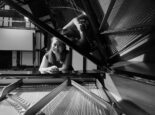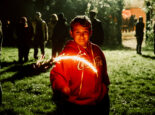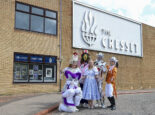Interview: Ray Harryhausen

When Ray Harryhausen went to see King Kong he was bitten by the special effects bug. Soon, he was assisting King Kong animator Willis O’Brien to creation of gorilla pic Mighty Joe Young. Harryhausen went on to breathe life into some of the most memorable animated creatures in film history – from the 50s science fiction classics The Beast From 20,000 Fathoms and It Came From Beneath The Sea to mythological epics such as The Seventh Voyage Of Sinbad, Jason And The Argonauts and Clash Of The Titans. In 2001 he attended at Cambridge Film Festival, and Toby Venables talked to him.
CGI involves hordes of people, but all your work you did on your own. Were you also directing the live action sequences to which your effects would be added?
Oh absolutely, yes. I always directed my own scenes. I worked on the script. I don’t just wear the hat of a special effects person. There are a lot of people that would call me an animator of special effects, which would suggest you’re handed a script and you’re supposed to try and put it on the screen. But I worked with the writers very closely, I’d make pre-production drawings, and those stimulate the actors, as well as the writers, and a lot of these things are put into the script.
And many of the films were built around ideas that you brought to your producer Charles Schneer?
Yes. I brought in The Seventh Voyage of Sinbad, I had a whole idea which we got a professional scriptwriter to devise a script for it, which I worked with him on, and I brought in The Golden Voyage Of Sinbad and The Eye Of The Tiger, as well as 20 Million Miles To Earth.
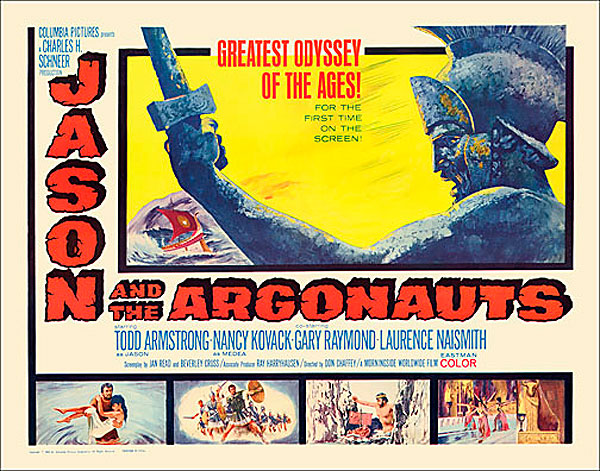 Of course, there is still a lot of stop motion animation being done today…
Of course, there is still a lot of stop motion animation being done today…
But they’re in the form of puppet films, whereas the type of films which Willis O’Brien started with King Kong and The Lost World are films where your animated character is a character in the story that you’re telling, rather than a puppet. Chicken Run is a wonderful example of a beautifully made puppet film, but everybody knows it’s a stylised puppet. In Mighty Joe Young and King Kong you had the character as an actor, as a part of the intricate storytelling process.
I believe you thought about being an actor, but had stage fright…
Yes I did. I studied acting at Los Angeles City College, and the two ladies that were just ahead of me in the class made it in the big time in Hollywood. But I remember when I was in my senior play, I hated the opening night, where you have all this tension around – remember your lines, is your fly open, you know all these horrible things that go on in one’s mind when you’re before the public. So I preferred to be behind the curtain! But I’m grateful for that period where I wanted to study acting, because our animated characters intrinsically act with the live actors, rather than just being there for shock value. Mighty Joe Young you would see a lot of acting with.
How much of that was from watching Willis O’Brien, the animator for King Kong?
Oh a lot of it, because Willis O’Brien was my mentor. When I saw King Kong, I was just awestruck, I couldn’t believe it, that anything like that could be done. I had the great pleasure of working with him on Mighty Joe, but I was just his assistant. I created a little bit, a few things, but nine tenths of it was his. His style of film concept rubbed off on me, of course, because of King Kong. All those little intricacies… I tried to put that in Mighty Joe Young – O’Brien left most of the animation to me – by having him pound the ground with his fist every time he was angry. That seemed to be a good characterisation, giving him a little more than just being a mad monster.
Your last film was Clash of the Titans. What was it made you decide to stop at that point?
Well I thought I’d had enough of it; the rest of the crew would go out and make three or four pictures while I was still on one film. That was one reason, there were personal reasons too, and then the other reason was the type of story that seemed to be popular in the eighties and nineties – it wasn’t my cup of tea. I like Greek mythology and you can’t tell a story like that with an explosion every five minutes. But now people just want special effects for the sake of special effects. Or at least that’s what Hollywood thinks. There’s no story.
Were you glad to stop?
Well I was at the time, but I miss it a lot, because I found it very creative, from developing the screenplay rather than actually doing it. As Hitchcock once said, ‘Your work is really done when you’ve written the script with all the details in it.’ The next step of course is hoping that you can get that on the screen… I used to make about four hundred little sketches that were published in the script, for the scenes that are all my work, so that when I would direct that sequence, sometimes the director would resent that. There were clashes of personality occasionally. You tried to keep that at a minimum…
I was interested to discover quite recently that you were a close friend of science fiction writer Ray Bradbury.
Oh yes. I first met him in ’38 or ’37, when he was a struggling writer. A group of us, used to meet at Clifton’s Cafeteria. We used to talk on the telephone, when for five cents you could talk for an hour. He lived in Venice, quite a distance from where I lived, and we used to talk about making films together on the telephone for I don’t know how long. If you did that today it would have cost you a fortune! We ended up making The Beast From 20,000 Fathoms together, from his story.
I also remember you saying that you got itchy feet and wanted to leave Hollywood and go to Europe.
Yes I did, so I wrote this story, which became 20 Million Miles To Earth… I just called it The Giant Aemir at the time. I wanted to go to Europe, and I had this outline for a story where a rocketship crashes in Lake Michigan in Chicago. So I changed it to Italy because I wanted a trip to Italy! And by George I got it.
What made you decide to settle in London?
Well we came over for two pictures actually in the sixties. We filmed a lot in Spain, and the locations were closer. To take a crew from Hollywood to Europe is very costly. Here in England it’s only two hours to Spain, and two hours to Italy, and we used a British crew. Our first cameraman here was Wilkie Cooper, and he took a skeleton crew to Spain.
When you say a ‘skeleton crew’…
No I don’t mean skeletons with bare bones! But I mean what they could term a skeleton crew, and then we used mostly the Spaniards – they had wonderful art directors there. We shot quite a few – six films – over in Spain. Another advantage of living in England was it’s closeness to new locations. In America, of course, television eats up all the locations. And you can’t use Malibu Beach for The Lost Island… In Spain, when we shot a lot of close-ups for The Lost Island, we used some live edible crabs, six of them, I think, and we had a nice dinner of them. Eat your actors when you’ve finished with them! Hitchcock would have been pleased.
Is Jason And The Argonauts your favourite film?
Jason I think is the most complete. The whole picture was shot in Italy. We used the temples which are four thousand years old – Greek temples. We had wonderful locations. But there are bits and pieces of other films I admire more. I wish I could shoot some of them over again!
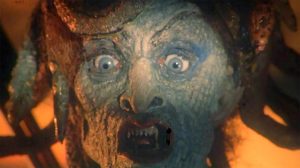 The fighting skeletons in Jason probably are what stick most in people’s minds, but the other is Medusa from Clash of the Titans…
The fighting skeletons in Jason probably are what stick most in people’s minds, but the other is Medusa from Clash of the Titans…
I always wanted to animate a Medusa, because I saw the Hammer film they called Medusa, and it was just a woman with rubber snakes in her hair, and every time she walked they would bounce! And I thought, oh God, you can’t call that Medusa! So I designed her so that she wouldn’t have to wear clothing by giving her a snake’s body, which fit perfectly with the story, and we gave her a bow and arrow and a rattlesnake’s tail, so that the sound effects that we used could be quite creepy, and she could destroy people from a distance. We gave it very spooky lighting…
Did you have a larger model for when you showed just the head?
No, we shot all the close-ups on that one model, and they were detailed enough so that you could photograph them close up.
Why not make them larger?
Well, the skeleton’s only eight inches, and the reason for that is because of your projection – the basic principle of animation is miniature rear projection. You project on the screen and have your stop motion models in front. The larger you project, the more grain, and then you have to re-photograph the grain of the projected image, so I try to keep the picture as small as possible. That’s why the models are small.
Tim Burton used your spaceships from Earth Versus The Flying Saucers for Mars Attacks, of course. But I believe there’s a curious story about their sound…
Oh, the sound effects were recorded at the Redondo sewage disposal plant! We filmed there for the inside of the rocketship to save building the set, because they had all levers and things. And then Charles heard this goo going through the sewage plant, and he said ‘Ah that makes a good sound for the saucer.’ So we recorded everybody’s residue going through the pipes and we incorporated it as the flying saucer sound, to make it sound extraterrestrial!
I think Earth Versus The Flying Saucers was the first film to really show a flying saucer.
Well, usually they avoided it or just showed a hubcap on a wire. Otherwise it was just a big prop. We tried to make it as though you were actually there, and you could see it coming up behind the car. Even in Close Encounters they used a similar thing with the lights, only the lights came up behind the car.
Did you enjoy Jurassic Park?
Oh yes, very much. I thought the dinosaurs were superb. I also liked Walking with Dinosaurs, the BBC programme. That was remarkable.
Spielberg strikes me as someone else who is resisting the urge to grow up.
Oh yes, you become jaded if you grow up…
What do you think about CGI animation in general…?
Oh I think CGI does some wonderful things, but I don’t see why you should throw everything else out just because CGI is good. I see no reason why it can’t be combined, after all what is the end product? It’s to entertain…
I saw Tomb Raider recently, and there was a scene in which a stone statue of a many-armed goddess armed with swords comes to life…
I wonder where they got that idea? [Chuckles]
#VirtualFilmFest









